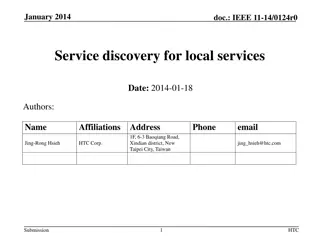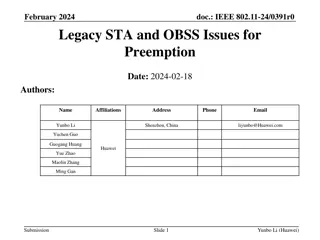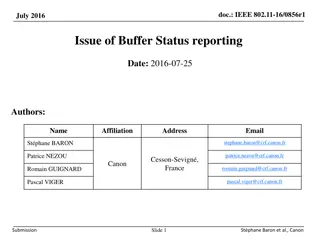Coordinated Roaming Proposal for IEEE 802.11 Networks
This document presents a proposal for coordinated roaming through target AP MLD in IEEE 802.11 networks to address connectivity disruptions due to sudden RSSI drops or STA transition scenarios. The solution aims to ensure data continuity, preserve context, and minimize data loss during roaming hando
0 views • 11 slides
Progress on IEEE 802.11 Multi-link Setup
Significant developments have been made in the multi-link setup within the IEEE 802.11 framework. The focus is on allowing only one STA in the MLD framework, differentiation with STA-level associations, and the rationale behind restricting to one STA. Proposals for defining multi-link devices and re
0 views • 12 slides
IEEE 802.11-20/0668r1: EHT BSS Configuration Proposal
The document discusses the configuration of a 320 MHz BSS in the context of 6 GHz regulations, focusing on EHT operation elements such as channel width indication, CCFS principles, and BSS advertisement settings. It proposes design principles for managing legacy and EHT STA operations, emphasizing s
0 views • 14 slides
The Benefits of Investing in Custom Creative Banner Stands for Trade Shows
The crowd passes by the road every day and sees many advertisements. However, poor visibility due to texture and quality can negatively impact advertising standards and the brand image. I recommend using PosterGarden\u2019s custom Creative Banner Sta
1 views • 11 slides
Discussion on Multi-RU Allocation in IEEE 802.11be Standard
In January 2020, a discussion took place on the allocation of multiple Resource Units (RUs) to a single Station (STA) in the IEEE 802.11be standard. The proposal suggested categorizing RUs into small and large types, avoiding aggregation across multiple 20MHz channels. It emphasized assigning a sing
2 views • 29 slides
Understanding IEEE 802.11-22/2083r1 Wake-Up Radio (WUR) and MC-OOK Signals
The document explores the IEEE 802.11-22/2083r1 specifications regarding Wake-Up Radio (WUR) PHY, focusing on WUR PPDU reception requirements and the use of multicarrier on-off keying (MC-OOK) signals. It examines the ambiguity surrounding MC-OOK in WUR PPDU compositions, emphasizing the need for cl
0 views • 27 slides
IEEE 802.11-20/0054r1 MLD MAC Address and WM Address
In the document IEEE 802.11-20/0054r1, the focus is on Multi-Link Framework for MLD address identification and differentiation. It explains the usage of MLD MAC address and STA WM medium address in wireless setups. The document also addresses the need for identifying different MLDs using MAC address
0 views • 16 slides
Exploring Wi-Fi Sensing for Motion Detection and Beyond
The document discusses the utilization of Wi-Fi signals for sensing various features in a given environment, such as motion, presence, gesture, and more, without assuming the subject carries a Wi-Fi device. It covers applications, technical principles, and a three-phase algorithm for motion detectio
0 views • 24 slides
Revisiting the IEEE 802.11-19/1340r2 Tone Plan Optimization
Revisiting the tone plan optimization for IEEE 802.11-19/1340r2, addressing issues with RUs near band edges, accommodating various STA bandwidth capabilities, and the inefficiencies of non-SST 11ax STAs in different BSS scenarios. Proposals include adapting to unknown future 11ax features, minimizin
5 views • 12 slides
Considerations on 6 GHz Discovery for IEEE 802.11-18/1922r0
IEEE 802.11-18/1922r0 document discusses the background and regulatory context for supporting 6 GHz operation in 802.11ax networks. It focuses on optimizing the discovery process for 6 GHz channels to enhance STA and network KPIs. The typical scanning/discovery procedure for non-AP STAs is outlined,
2 views • 14 slides
Comparison of Trigger-based vs. Non-Trigger-based Sensing Measurement in IEEE 802.11
The document discusses the differences between Trigger-based (TB) and Non-Trigger-based (Non-TB) sensing measurement instances in IEEE 802.11 standards, focusing on who initiates the sensing measurement. TB sensing is initiated by the AP, while Non-TB sensing is initiated by a non-AP STA, enabling o
6 views • 13 slides
IEEE 802.11-20/1108-00-00be MLO Probe Mechanism in AP MLD
This document discusses the design and implementation of a mechanism for a non-AP STA to send a probe request frame to an AP within an AP MLD, allowing the STA to request a probe response containing information on all APs affiliated with the same MLD as the target AP. It proposes the use of new elem
1 views • 12 slides
Understanding Dynamic Voltage and Frequency Scaling in Advanced VLSI
Explore the concepts of Dynamic Voltage and Frequency Scaling (DVFS) in Advanced VLSI design. Learn about the impact on clocking, STA, and testing, as well as considerations for selecting the right voltage and frequency settings. Discover how controlling voltage affects power consumption and computa
0 views • 51 slides
IEEE 802.11-20/0644r0 NAV Setting in Multi-AP Operation
This document discusses the NAV setting in multi-AP operations within the IEEE 802.11-20 standard. It covers terminology, background information, and proposed solutions to address issues related to AP cooperation and UL AP coordination. The authors suggest adjustments to NAV rules and frame duration
0 views • 9 slides
Enhanced AP Coordination in IEEE 802.11 Networks
The document discusses the implementation of Restricted Transmit Wait Time (R-TWT) scheduling in IEEE 802.11 networks. It covers topics such as AP coordination, announcement of R-TWT schedules by APs, usage of 1-hop and 2-hop neighbor information for scheduling, and STA's notification of neighbor AP
0 views • 7 slides
IEEE 802.11-15/1064r0 Long Range, Low Power Design Criteria Study
Submission on design criteria for Long Range, Low Power (LRLP) in WLAN systems aiming to enhance transmission reliability and range while ensuring compatibility with existing WLAN networks. The key technical components include ultra-low power consumption, communication range extension, and coexisten
0 views • 8 slides
Service Discovery for Local Services in IEEE 11-14/0124r0 Document
Elaboration on non-tethering Soft AP and possible service network scenarios in the January 2014 IEEE document. It discusses the concept of non-tethering Soft APs, their operation in the vicinity, and the categories of use scenarios related to Internet access and service discovery. The document cover
0 views • 9 slides
Virtual Carrier Sense in Multi-Link Networks
This document discusses the implementation and advantages of virtual carrier sense in multi-link networks under the IEEE 802.11 standard. It explores the operation of multi-link setups, asynchronous communication benefits, and the necessity of multiple contention channels. The concept of NAV (Networ
2 views • 11 slides
Enhancing Support for Wider Bandwidth OFDMA in IEEE 802.11 Networks
The document discusses the implementation of Selective Spatial Transmission (SST) and Dynamic Subband Operation (DSO) to enable wider bandwidth OFDMA in IEEE 802.11be and 802.11bn standards. It covers enhancements for 80MHz, 160MHz, and 320MHz EHT DL and UL OFDMA transmissions, emphasizing the benef
0 views • 18 slides
AMP Link Access Modes in IEEE 802.11-24 Presentation
Presented in the March 2024 document IEEE 802.11-24/0421r0, Solomon Trainin from Wiliot discusses three modes of AMP link access, including random access of multiple AMP STAs, access of a single AMP STA, and exemplary frame exchanges for each mode.
0 views • 10 slides
Discussion on IEEE 802.11 Group vs. Individual Epochs
Trigger discussion on differences between group and individual epochs in IEEE 802.11 standards. Group epochs involve simultaneous transitions of MAC parameters by all or selected STAs based on AP trigger, while individual epochs allow each STA to independently change its parameters. Key points inclu
0 views • 4 slides
Update on Multibeam and Sonar Systems for USCGC Healy
The update for USCGC Healy includes recommendations for multibeam and sonar systems, such as utilizing either Kongsberg EM124 or EM304 with additions like shallow water mapping and EK80 Fisheries Sonar capability. Two high-resolution multibeam options are detailed: Option 1 pairs Kongsberg EM712 wit
0 views • 16 slides
IEEE 802.11-20/0834r6: Make Before Break Scheme Implementation
This document discusses the Make Before Break scheme to minimize data delivery interruptions during roaming for a single-radio STA. It addresses the challenges of interrupted data delivery during tentative association with a new AP on a different channel and proposes solutions to implement this sche
0 views • 21 slides
IEEE 802.11-24/0797r0 Operating Mode Request
This document proposes an Operating Mode Request mechanism for STAs within the IEEE 802.11 standard. It allows a STA to request another STA to change its operating mode, such as bandwidth and number of spatial streams. The proposal outlines the reasons for making such requests and the acceptance/den
0 views • 10 slides
Proposal for Mobile-AP Power Save in IEEE 802.11
This proposal by Neel Krishnan and team from Apple addresses the need to reduce power consumption in software-enabled access points (Mobile-APs). The focus is on prolonging battery life by minimizing power usage while ensuring full capabilities for associated STAs. The solution involves transitionin
0 views • 11 slides
Implications of IEEE 802.11 State Machine and MAC Randomization
The document discusses the state machine transitions in IEEE 802.11, focusing on MAC address handling and implications for STA connectivity within an ESS. It explains the scenarios where a STA can use different MAC addresses, emphasizing the binding of state to specific address configurations and th
0 views • 11 slides
Addressing Privacy Concerns in IEEE 802.11-21: Changing MAC Addresses for Improved Security
The document discusses the implications of changing STA MAC addresses per association in IEEE 802.11-21 standard to enhance privacy and security. It explores the challenges of maintaining persistent identifiers in data frames and the risks associated with sending source/destination addresses in clea
0 views • 11 slides
IEEE 802.11-24/0386r0 Lower MAC Relay Protocol Details
Detailed discussion on supporting the relay protocol in IEEE 802.11bn, covering relay addressing, end-to-end BA, relay TXOP protection, beacon forwarding, security processing, non-UHR STA support, sounding procedure, A-MPDU aggregation, de-aggregation, and more. The relay operation involves relay de
0 views • 16 slides
IEEE 802.11-15/1306r0 Use Cases for LRLP and Full Function in STA
The documents related to IEEE 802.11-15/1306r0 explore various use cases for LRLP (Low-Rate Longevity-Performance) and full functional capabilities in Single Terminal Architecture (STA). Tim Godfrey from EPRI presents scenarios where AP/STA pairings with 802.11ax and LRLP are approved and deployed,
0 views • 7 slides
Proposal to Simplify MLD Max Idle Period for Non-AP MLDs
Proposal presented in March 2020.doc suggests defining the MLD Max Idle Period at the MLD level instead of the STA level for non-AP MLDs. The objective is to indicate to APs through keep-alive frames that the non-AP MLD is still active without needing to tear down multi-link setups. The proposal off
0 views • 4 slides
Proposal for Improved Channel Access Efficiency in IEEE 802.11 Networks
The proposal addresses the inefficiencies in utilizing secondary channels in IEEE 802.11 networks, aiming to enhance access to wideband channels (>20 MHz) when the primary channel is busy. It introduces a mechanism for APs and STAs to access available secondary channels while the primary channel is
0 views • 7 slides
Legacy STA and OBSS Preemption Considerations in IEEE 802.11-24
Discussions in IEEE 802.11-24 address preemption issues related to UHR STAs within a single BSS, focusing on legacy STA impact and OBSS considerations. Proposed solutions aim to balance efficiency and latency by adjusting TXOP limits for different STA types.
0 views • 7 slides
Solicited Method for Critical Update in Multi-Link Environments
This document discusses a method for obtaining critical update information for Access Points (APs) within the same Multi-Link Domain (MLD) in IEEE 802.11 standards. It introduces the concept of Change Sequence fields in Beacon and Probe Response frames to indicate changes in system information for o
0 views • 18 slides
Implementation and Demonstration of eBCS Concept in IEEE 802.11-19/1999r0
This presentation showcases the implementation and demonstration of the eBCS concept, including the system architecture, utilization of eBCS AP and STA, web server functionality, and data transmission processes. It covers the use of LDPC-Staircase/Triangle for packet transmission, IP multicast for d
0 views • 9 slides
Discussion on IEEE 802.11-23/1865r0: SST and A-PPDU
The document discusses the current lack of support for SST on S160 in 11be, highlighting that 11be AP and STA do not support A-PPDU. It explores potential combinations for A-PPDU involving UHR and non-UHR HE and EHT STAs, addressing bandwidth enhancements and benefits of various scenarios. The analy
0 views • 14 slides
January 2016 IEEE 802.11-16/0104r0: Rate Matching for HE-SIG-B
The document from January 2016 focuses on rate matching for HE-SIG-B in IEEE 802.11-16/0104r0 standard. It delves into the encoding/decoding structure, example of SIG-B with code-rate, MCS table, proposed encoding method for HE-SIG-B, and the structure of HE-SIG-B per-STA information field. The cont
0 views • 10 slides
IEEE 802.11-22/0424r1 - MAAD MAC Protocol Overview
The document discusses the MAAD MAC protocol, where the AP assigns a MAAD MAC address to the STA during association. Key differences from other schemes are highlighted, emphasizing the use of MAAD MAC addresses as identification. Details on support indication, address allocation, and recognition mec
0 views • 7 slides
Efficient UL Buffer Status Reporting in IEEE 802.11 Networks
IEEE 802.11-16/0856r1 discusses the importance of UL buffer status reporting in 11ax for efficient resource allocation. The document addresses managing unmanaged P2P flows to enhance buffer status reporting accuracy. It proposes solutions to prevent misallocation of resources due to large data amoun
0 views • 11 slides
UL Sync Channel Access Procedure in IEEE 802.11-20/1730r1
The document discusses the UL sync channel access procedure in IEEE 802.11, focusing on the conditions under which an STA affiliated with an MLD can initiate transmission, manage its backoff counter, and follow specific rules for accessing the channel. It proposes a straw poll to gather support for
0 views • 8 slides
Suffolk County Early Intervention: Expert Support for Developmental Delays
Suffolk County early intervention services at Theralympic Speech provide comprehensive evaluations and therapy for children with developmental delays. Our experienced team is dedicated to supporting families and ensuring children receive the best sta
3 views • 7 slides







































